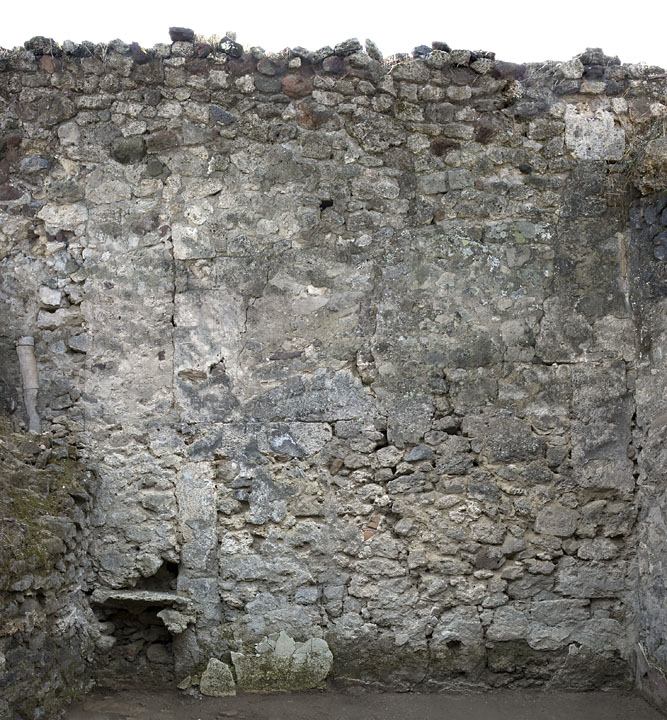South Wall
Description
Henrik Boman & Monika Nilsson
The masonry of the south wall of room f is well preserved, but little remains of the painted wall plaster.
The wall is built with large limestone blocks in the opus africanum technique with small and medium sized stones in between, mainly of limestone but also with unusually many tufa and some cruma and lava. The topmost 0.50m, or so, of the wall is a modern restoration. Large areas have earth mortar, rich in lime pellets, or under plaster still attached, but pieces of painted plaster are mainly to be found close to the floor. A roughly vertical line in the centre of the wall has been filled in with mortar with crushed pottery sherds and tiles.
The early type A plaster was identified, but it was covered with type G painted red. These samples were recovered from the SW corner, where the plaster clearly continues behind the W wall. The red-painted plaster along the floor still had a glossy surface (due to the protective heap of dumped soil that had been kept in the room) at the time of the investigations. When the dump was removed, large chunks of white plaster painted with red and yellow filigree bands were found resting against the wall. They were clearly pieces that had fallen down from the wall’s mid section.
The E wall has crumbled, thereby exposing the surface of the south wall where it had attached. Here is a white fine plaster of type D. A terracotta pipe, not completely vertical but slightly askew, is embedded in the south wall behind the shortend of the E wall. It presumably continues down to the conduit under the floor which starts in the SE corner.
There are, however, some enigmatic features of the wall in the SE corner. A vertical section of the wall, in line with the E wall, appears to be a filling, but its height and width is unusual. Perhaps it is an ancient wall restoration after the repair or removal of a built-in drain. At the bottom of this section is a cavity in the wall, which at the time of the investigations was filled with loose soil. A thin slab of, most likely, modern cement appears to hover in the upper part of the cavity, but it is attached to the stones and continues into the wall. Its presence could perhaps be explained as the dumped cement on top of the pile of soil and waste that had accumulated in the room. When poured out, it would have floated into the wall before it solidified.
The cache in the wall
The cavity was investigated and proved to contain both man-made finds, like two lamp nozzles and two glass beads (see details below), and animal remains, including a rodent’s skull, eggshell fragments and the large part of a snake. (Some of the bones of the snake, and possibly its skull, were attached to the underside of the cement and could not be removed.) The dilapidated state of the wall in the lower SE corner rendered a thorough search for more small finds inside the wall impossible. Now, the question is how to interpret the find. Various types of animals could choose to nest in a hole or crevice in the wall, including the ones we found remains of, i.e. rats, snakes and even birds. In the case of the birds, the eggshell fragments could have fallen down from the top of the wall, if the vertical section is hollow on the inside or hides an old conduit. There is no way of knowing when these animal remains ended up inside the wall - they could be either ancient or modern. The context, however, suggests that they are ancient. Bones from fish and rooster, sea shells and man-made artefacts would have to have been deposited in the wall, although perhaps not intentionally in case the wall contained a pipe that broke. The two lamp nozzles are, nevertheless, suggestive of an intentional deposition since no other lamp parts were recovered. It should also be noted that there are no signs of the lime or stale crust that we normally find in pipes and wall conduits.
The contents of the cache:
- Numerous animal bones, including a rodent’s skull, larger mammal bones, a rooster’s spur, fish bones and many snake vertebrae.
- Eggshell fragments.
- Sea shells.
- One bronze nail.
- Crude pottery sherds.
- Two white glass beads, one of which is very small. They are of the type commonly found in Pompeii, i.e. not pierced and perhaps rather used as chips for board games than for jewellery.
- Two lamp nozzles. No other parts of the lamps were found.

